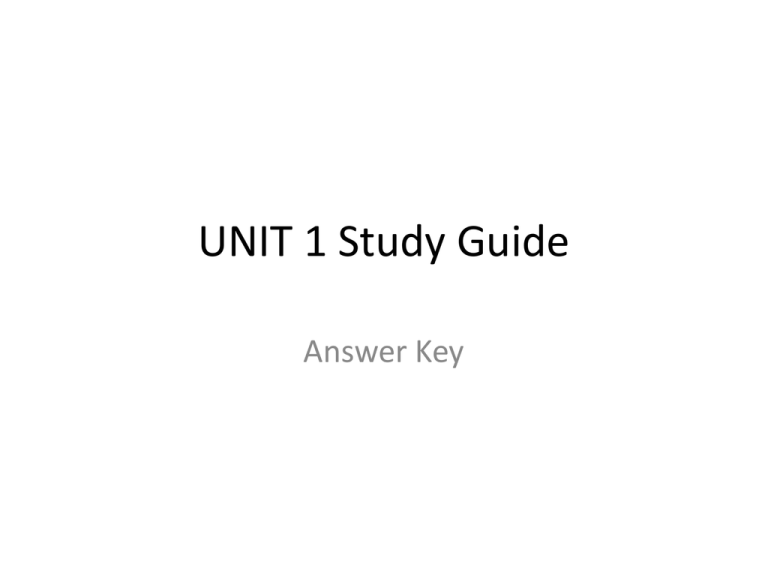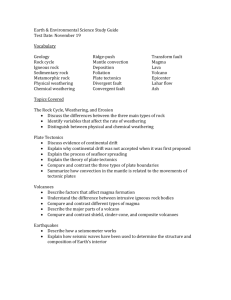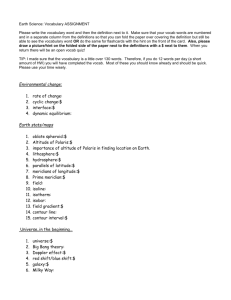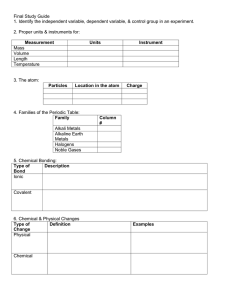UNIT 1 Study Guide Answer Key
advertisement

UNIT 1 Study Guide Answer Key Energy From Stars #1 Nuclear fission = nuclei splitting, used in nuclear power plants Nuclear fusion = nuclei combining, used in stars to make energy #2 Nuclear fusion Energy From Stars #3 conduction from the core, convection to the surface, radiation out into space #4 radio, microwave, IR, visible, UV, xray, gamma #5 some radio, some IR, some UV, all visible #6 gravity and pressure Plate Tectonics, Rock Cycle, E & V #1 label the rock cycle #2 core of the Earth, the Sun #3 core, mantle, crust; density of the materials #4 Alfred Wegener Plate Tectonics, Rock Cycle, E & V #5 jigsaw puzzle, fossil record, rock formations; Pangaea #6 mantle convection #7 divergent; convergent Plate Tectonics, Rock Cycle, E & V #8 convergent – plates move together; mountains, island arcs, trenches; destroy crust Divergent – plates move apart; rift valleys, shallow seas, mid-ocean ridges; create crust Transform – plates slide past each other; long faults, shallow earthquakes; conserve crust Plate Tectonics, Rock Cycle, E & V #9 focus = place inside the Earth where an earthquake occurs; epicenter = place on the surface over the focus #10 normal = divergent Reverse = convergent Slip-strike = transform Plate Tectonics, Rock Cycle, E & V #11 p waves – 1st to arrive, push-pull through the Earth s waves – 2nd to arrive; shake up and down through the Earth Surface – last to arrive; move along the surface of the Earth, most destructive Plate Tectonics, Rock Cycle, E & V #12 waves are measured from at least three seismic stations, a time distance graph is used to triangulate the location #13 by intensity (amount of shaking/destruction at an area) and magnitude (amount of energy released at the focus) Plate Tectonics, Rock Cycle, E & V #14 tsunamis, fires, landslides, seismic vibrations #15 magma composition, magma temperature, amount of dissolved gases, magma viscosity Plate Tectonics, Rock Cycle, E & V #16 divergent boundaries = shield volcanoes with cinder cones along the edges Convergent bondaries = composite cones Predicting Earthquakes & Volcanoes #1 False #2 at any place where tectonic plates meet; most earthquakes and volcanoes are found along the edge of the Pacific Ocean aka the Ring of Fire Weathering, Erosion and Soil #1 mechanical weathering = rock composition stays the same no matter how small the piece of rock; frost wedging Chemical weathering = rock composition CHANGES from one form to another; water dissolving limestone Weathering, Erosion and Soil #2 rock characteristics, climate, differential weathering #3 mineral matter, organic matter, water, air #4 parent material, topography, climate, organisms, time Weathering, Erosion and Soil #5 topography – steep land = little soil; flat land = a lot of soil Climate – cool, dry, little vegetation = mostly mechanical weathering; warm, wet, lots of vegetation = mostly chemical weathering (faster process) Weathering, Erosion and Soil #6 O = top layer with leaves, grass, etc. A = topsoil; most fertile layer B = subsoil; some organic matter found here C = broken up parent material R = bedrock; solid parent material #7 True #8 False Mass Movement & Geohazards #1 triggers = water, over-steepened slopes, removal of vegetation, earthquakes Types = rockfalls, slides, slumps, creep, flows #2 landslides, mudslides, avalanches, falling rock, volcanoes, earthquakes, floods #3 levees, dams, wire netting, breaks, special building codes





